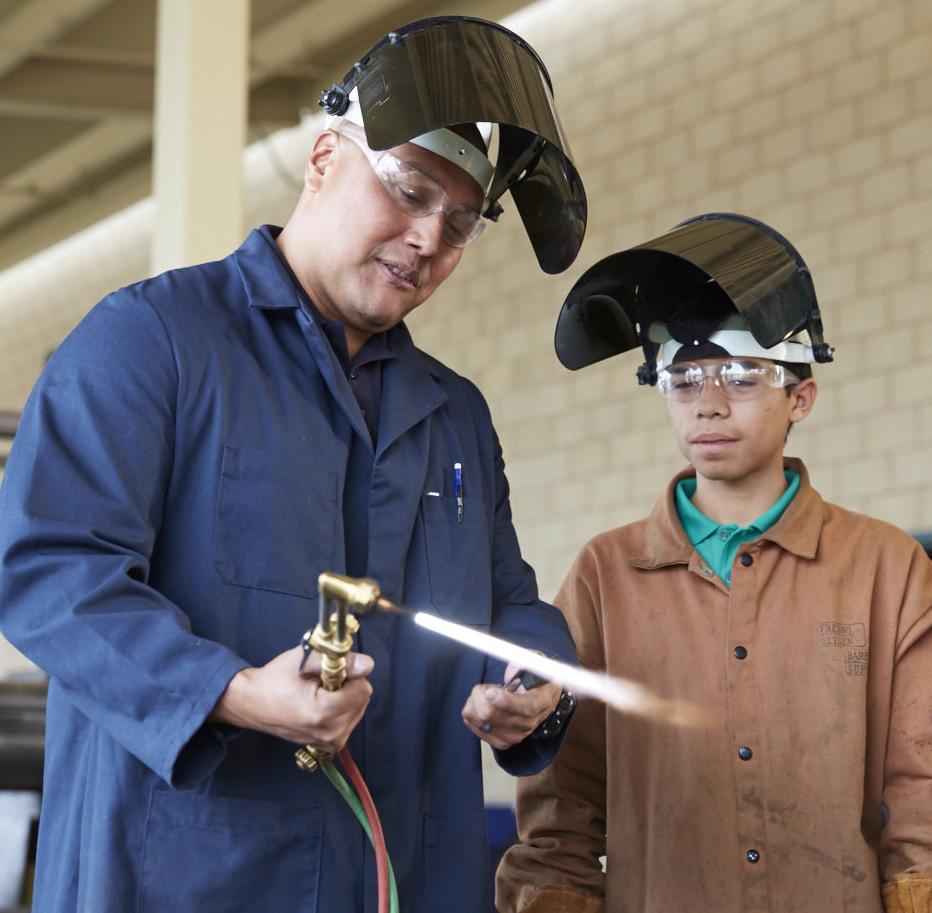
5 minute read
Alignment Partners
SECTION 2
Alignment Partners

Figure 2 Key Alignment Partners
Community and Economic Development
State Government Agencies
K-12 Education
ALIGNMENT PARTNERS
Trade Associations
Postsecondary Education (2-year and 4-year)
Business and Industry
Ensuring appropriate alignment with postsecondary and business and industry needs requires
collaboration. It starts with gathering your partners. Each partner has a vested interest in ensuring alignment between education and career. Educational institutions want their students to succeed after graduation, and employers want to have access to the best talent possible. Once you have gotten your partners together, you will need to conduct a needs assessment to determine what needs you are currently meeting and where you may be falling short. More information on the needs assessment can be found on page 12.
You need partners at the table to help you conduct a needs assessment and establish strategies for aligning your curricula and programs to postsecondary and business and industry needs. You cannot and should not do this alone. There are specific partners at each step along the career pathway pipeline (see Figure 1 on page 2). Descriptions of each of these partners are provided below.
K-12 Education
It is important to include all K-12 stakeholders that may be impacted by the outcome of the needs assessment process, such as teachers, school counselors, CTAE directors, work-based learning coordinators, career coaches, and middle school educators and counselors. Depending on the district, the superintendent and other administrators may need to be involved as well. You may also consider taking a multidistrict approach to the needs assessment process and involving several school districts in the region in your analysis and planning efforts.
Postsecondary Education
Representatives from local colleges and universities, including TCSG and USG institutions and private colleges, should be included in the process. The exact representative will vary depending on the school and the program. Key points of contact could be postsecondary dual enrollment coordinators, TCSG vice presidents of economic development, vice presidents of academic affairs, and an instructor and dean from the applicable department related to the specific alignment areas being considered. Much like K-12 institutions, other administrators may need or want to be included in the process.
Business and Industry
Including local and regional employers is pivotal to making alignment work. If you need help identifying the employers in your community, ask your community and economic development partners to help make those connections. Be sure that you do not just include the big businesses: Think about smaller firms and companies that do not fall directly in the industry but still may be able to employ students from pathways you are targeting. For instance, if you are looking to start a marketing program, nearly every business has some need for marketing even if they do not have a dedicated office or person assigned to that role.
UNDERSTANDING THE BIG PICTURE
“Employers and businesses are in the unique position to provide information about their own workforce needs.
Industry-driven partnerships enable industry representatives to share information about their workforce needs projections, skills and competencies necessary for success, and the current sources of their talent. Partners start by analyzing an industry’s current and future skill needs and identifying occupations with skill gaps before developing a plan to close these gaps. Identifying where and when businesses need workers, the skills workers need to have to start a work-based learning program, how those skills should progress over time, and the pathways to that skill development are all at the foundation of an industry partnership’s goals.”7
National Skills Coalition
Trade Associations
Depending on the particular pathway, it may be important to include local, state, or national trade associations. A good way to find out about such organizations is to talk to other school districts that already have that pathway and see who they have on their advisory committees or who was involved in their needs assessment process. Another way to learn about industry trade or professional associations is to ask your business and industry partners. Many of them will be members of such organizations or be involved in some way and can probably point you in the right direction. While this may seem like one of the harder partners to get to the table, trade associations can provide a lot of resources that others may not be able to. Typically, associations have existing curricula or information that can be helpful during the needs assessment.
State Government Agencies
Many state agencies have resources that you can use in your needs assessment or as part of your pathway. Or they can put you in touch with the right resources or partners to assist in your alignment efforts. Representatives from your local workforce board, the Georgia Department of Economic Development, the Georgia Department of Labor, and the Georgia Vocational Rehabilitation Agency are all potential partners.
Community and Economic Development
Every community has different community and economic development organizations, so it is important to get to know them and involve them in your needs assessment process. After all, one way they are selling your community to prospects is the quality of the school district and the future workforce. Some of the common representatives in this category are members of the chamber of commerce, members of the economic development council or authority, utility community and economic development representatives, members of workforce boards, and community development corporation members.
Use the Partner Worksheet in Appendix A to create a list of the partners that should be included in your community’s needs assessment process.
Intermediaries
Building relationships with local and regional business partners can be difficult for many CTAE teachers as they have numerous school-based responsibilities and limited opportunities to attend chamber meetings, call on businesses, or work to build relationships with regional employers. Often, intermediary organizations—like chambers of commerce, economic development organizations, and trade associations— can help to connect educational programs with relevant businesses that may be willing to partner.




